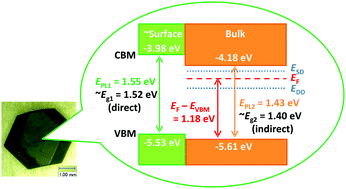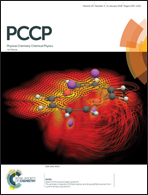Energy level diagram of HC(NH2)2PbI3 single crystal evaluated by electrical and optical analyses
Abstract
Recently, organic–inorganic halide perovskites have received attention for applications in solar cells. Measurements of high-quality single crystals reveal lower defect densities and longer carrier lifetimes than those of conventional thin films, which result in improved electrical and optical properties. However, single crystal surfaces are sensitive to exposure to ambient conditions, and degrade under long-term storage in air. The surface also shows differences from the bulk in terms of its optical and electronic characteristics. For a heterojunction device, the interface at the single crystal is important. Understanding the difference between the surface and bulk properties offers insights into device design. Here, we prepared non-sliced and sliced formamidinium lead iodide (FAPbI3; FA+ = HC(NH2)2+) single crystals with a bandgap of 1.4 eV, which matches well with the requirements for solar cell photoabsorption layers. We evaluate the energy level diagrams of the surface and bulk regions, respectively. Our data indicate that the valence band maximum of the surface region is at a higher energy level than that of the bulk region. We also discuss hypotheses for the well-known and unexplained phenomena (multiple bandgaps and bandgap narrowing) seen in the absorption and photoluminescence spectra of single crystals. We conclude that these effects are likely caused by a combination of the degraded surface, Rashba-splitting in bulk, and self-absorption by the single crystal itself.

- This article is part of the themed collection: 2018 PCCP HOT Articles


 Please wait while we load your content...
Please wait while we load your content...